[English] 日本語
 Yorodumi
Yorodumi- PDB-6g9q: Ternary complex of P14 TCR with murine MHC class I H-2 Db in comp... -
+ Open data
Open data
- Basic information
Basic information
| Entry | Database: PDB / ID: 6g9q | ||||||
|---|---|---|---|---|---|---|---|
| Title | Ternary complex of P14 TCR with murine MHC class I H-2 Db in complex with self-antigen derived from dopamine monooxygenase. | ||||||
 Components Components |
| ||||||
 Keywords Keywords | IMMUNE SYSTEM / LCMV / cross-reactivity / MHC class I / TCR / APL | ||||||
| Function / homology |  Function and homology information Function and homology informationCatecholamine biosynthesis / dopamine beta-monooxygenase / leukocyte mediated immunity / dopamine beta-monooxygenase activity / regulation of vascular associated smooth muscle cell proliferation / regulation of vascular endothelial cell proliferation / chromaffin granule lumen / homoiothermy / regulation of extrinsic apoptotic signaling pathway / Phosphorylation of CD3 and TCR zeta chains ...Catecholamine biosynthesis / dopamine beta-monooxygenase / leukocyte mediated immunity / dopamine beta-monooxygenase activity / regulation of vascular associated smooth muscle cell proliferation / regulation of vascular endothelial cell proliferation / chromaffin granule lumen / homoiothermy / regulation of extrinsic apoptotic signaling pathway / Phosphorylation of CD3 and TCR zeta chains / Translocation of ZAP-70 to Immunological synapse / Co-inhibition by PD-1 / Generation of second messenger molecules / norepinephrine biosynthetic process / chromaffin granule membrane / Downstream TCR signaling / behavioral response to ethanol / vasoconstriction / dopamine catabolic process / fear response / alpha-beta T cell receptor complex / maternal behavior / Endosomal/Vacuolar pathway / DAP12 interactions / Antigen Presentation: Folding, assembly and peptide loading of class I MHC / L-ascorbic acid binding / ER-Phagosome pathway / DAP12 signaling / Immunoregulatory interactions between a Lymphoid and a non-Lymphoid cell / leukocyte migration / response to pain / T cell receptor complex / transport vesicle membrane / positive regulation of vasoconstriction / antigen processing and presentation of endogenous peptide antigen via MHC class I via ER pathway, TAP-dependent / associative learning / blood vessel remodeling / cellular defense response / Neutrophil degranulation / secretory granule membrane / response to amphetamine / lumenal side of endoplasmic reticulum membrane / locomotory behavior / cellular response to iron(III) ion / negative regulation of forebrain neuron differentiation / antigen processing and presentation of exogenous protein antigen via MHC class Ib, TAP-dependent / iron ion transport / peptide antigen assembly with MHC class I protein complex / regulation of iron ion transport / regulation of erythrocyte differentiation / HFE-transferrin receptor complex / response to molecule of bacterial origin / MHC class I peptide loading complex / T cell mediated cytotoxicity / positive regulation of T cell cytokine production / antigen processing and presentation of endogenous peptide antigen via MHC class I / visual learning / MHC class I protein complex / positive regulation of receptor-mediated endocytosis / negative regulation of neurogenesis / cellular response to nicotine / positive regulation of T cell mediated cytotoxicity / multicellular organismal-level iron ion homeostasis / centriolar satellite / memory / phagocytic vesicle membrane / negative regulation of epithelial cell proliferation / sensory perception of smell / positive regulation of cellular senescence / glucose homeostasis / T cell differentiation in thymus / negative regulation of neuron projection development / positive regulation of cold-induced thermogenesis / protein refolding / secretory granule lumen / protein homotetramerization / amyloid fibril formation / adaptive immune response / intracellular iron ion homeostasis / learning or memory / cell surface receptor signaling pathway / copper ion binding / external side of plasma membrane / structural molecule activity / endoplasmic reticulum / Golgi apparatus / protein homodimerization activity / extracellular space / plasma membrane / cytosol Similarity search - Function | ||||||
| Biological species |  | ||||||
| Method |  X-RAY DIFFRACTION / X-RAY DIFFRACTION /  SYNCHROTRON / SYNCHROTRON /  MOLECULAR REPLACEMENT / Resolution: 1.89 Å MOLECULAR REPLACEMENT / Resolution: 1.89 Å | ||||||
 Authors Authors | Achour, A. / Sandalova, T. / Allerbring, E. | ||||||
 Citation Citation |  Journal: to be published Journal: to be publishedTitle: Structural basis for CD8+ T cells auto-reactivity in LCMV infection Authors: Allerbring, E. / Duru, A.D. / Nygren, P.A. / Sandalova, T. / Achour, A. | ||||||
| History |
|
- Structure visualization
Structure visualization
| Structure viewer | Molecule:  Molmil Molmil Jmol/JSmol Jmol/JSmol |
|---|
- Downloads & links
Downloads & links
- Download
Download
| PDBx/mmCIF format |  6g9q.cif.gz 6g9q.cif.gz | 346.7 KB | Display |  PDBx/mmCIF format PDBx/mmCIF format |
|---|---|---|---|---|
| PDB format |  pdb6g9q.ent.gz pdb6g9q.ent.gz | 278.7 KB | Display |  PDB format PDB format |
| PDBx/mmJSON format |  6g9q.json.gz 6g9q.json.gz | Tree view |  PDBx/mmJSON format PDBx/mmJSON format | |
| Others |  Other downloads Other downloads |
-Validation report
| Arichive directory |  https://data.pdbj.org/pub/pdb/validation_reports/g9/6g9q https://data.pdbj.org/pub/pdb/validation_reports/g9/6g9q ftp://data.pdbj.org/pub/pdb/validation_reports/g9/6g9q ftp://data.pdbj.org/pub/pdb/validation_reports/g9/6g9q | HTTPS FTP |
|---|
-Related structure data
| Related structure data | 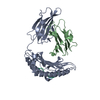 6g9rC 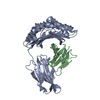 1s7uS S: Starting model for refinement C: citing same article ( |
|---|---|
| Similar structure data |
- Links
Links
- Assembly
Assembly
| Deposited unit | 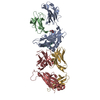
| ||||||||
|---|---|---|---|---|---|---|---|---|---|
| 1 |
| ||||||||
| Unit cell |
|
- Components
Components
-Protein , 4 types, 4 molecules ABGH
| #1: Protein | Mass: 32087.703 Da / Num. of mol.: 1 / Fragment: UNP residues 25-300 Source method: isolated from a genetically manipulated source Source: (gene. exp.)   |
|---|---|
| #2: Protein | Mass: 13794.978 Da / Num. of mol.: 1 Source method: isolated from a genetically manipulated source Source: (gene. exp.)   |
| #3: Protein | Mass: 23030.656 Da / Num. of mol.: 1 / Fragment: UNP residues 22-120,UNP residues 1-88 Source method: isolated from a genetically manipulated source Source: (gene. exp.)   |
| #4: Protein | Mass: 26663.633 Da / Num. of mol.: 1 / Fragment: UNP residues 11-122,UNP residues 1-127 Source method: isolated from a genetically manipulated source Source: (gene. exp.)   |
-Protein/peptide , 1 types, 1 molecules P
| #5: Protein/peptide | Mass: 1038.173 Da / Num. of mol.: 1 / Fragment: UNP residues 557-565 / Mutation: L3P / Source method: obtained synthetically / Details: Pro3 is replacement of Leu3 of wild type / Source: (synth.)  |
|---|
-Non-polymers , 2 types, 176 molecules 


| #6: Chemical | ChemComp-GOL / |
|---|---|
| #7: Water | ChemComp-HOH / |
-Details
| Has protein modification | Y |
|---|
-Experimental details
-Experiment
| Experiment | Method:  X-RAY DIFFRACTION / Number of used crystals: 1 X-RAY DIFFRACTION / Number of used crystals: 1 |
|---|
- Sample preparation
Sample preparation
| Crystal | Density Matthews: 2.78 Å3/Da / Density % sol: 55.72 % |
|---|---|
| Crystal grow | Temperature: 293 K / Method: vapor diffusion, hanging drop / pH: 8 / Details: Tris HCl pH 8.0 PEG 6000 / PH range: 7.5-9.0 |
-Data collection
| Diffraction | Mean temperature: 100 K |
|---|---|
| Diffraction source | Source:  SYNCHROTRON / Site: SYNCHROTRON / Site:  ESRF ESRF  / Beamline: ID23-1 / Wavelength: 0.9795 Å / Beamline: ID23-1 / Wavelength: 0.9795 Å |
| Detector | Type: DECTRIS PILATUS3 6M / Detector: PIXEL / Date: Apr 4, 2013 |
| Radiation | Protocol: SINGLE WAVELENGTH / Monochromatic (M) / Laue (L): M / Scattering type: x-ray |
| Radiation wavelength | Wavelength: 0.9795 Å / Relative weight: 1 |
| Reflection | Resolution: 1.89→50.5 Å / Num. obs: 80434 / % possible obs: 93.9 % / Redundancy: 3 % / Biso Wilson estimate: 32 Å2 / Rmerge(I) obs: 0.04 / Net I/σ(I): 16 |
| Reflection shell | Resolution: 1.89→1.99 Å / Redundancy: 2.6 % / Rmerge(I) obs: 0.58 / Mean I/σ(I) obs: 1.6 / Num. unique obs: 8616 / % possible all: 69.6 |
- Processing
Processing
| Software |
| ||||||||||||||||||||||||||||||||||||||||||||||||||||||||||||||||||||||||||||||||||||||||||||||||||||||||||||||||||||||||||||||||||||||||||||||||||||||||||||||||||||||||||||||||||||||
|---|---|---|---|---|---|---|---|---|---|---|---|---|---|---|---|---|---|---|---|---|---|---|---|---|---|---|---|---|---|---|---|---|---|---|---|---|---|---|---|---|---|---|---|---|---|---|---|---|---|---|---|---|---|---|---|---|---|---|---|---|---|---|---|---|---|---|---|---|---|---|---|---|---|---|---|---|---|---|---|---|---|---|---|---|---|---|---|---|---|---|---|---|---|---|---|---|---|---|---|---|---|---|---|---|---|---|---|---|---|---|---|---|---|---|---|---|---|---|---|---|---|---|---|---|---|---|---|---|---|---|---|---|---|---|---|---|---|---|---|---|---|---|---|---|---|---|---|---|---|---|---|---|---|---|---|---|---|---|---|---|---|---|---|---|---|---|---|---|---|---|---|---|---|---|---|---|---|---|---|---|---|---|---|
| Refinement | Method to determine structure:  MOLECULAR REPLACEMENT MOLECULAR REPLACEMENTStarting model: 1S7U.pdb Resolution: 1.89→50.42 Å / Cor.coef. Fo:Fc: 0.959 / Cor.coef. Fo:Fc free: 0.938 / SU B: 8.686 / SU ML: 0.112 / Cross valid method: THROUGHOUT / ESU R: 0.235 / ESU R Free: 0.144 / Details: HYDROGENS HAVE BEEN ADDED IN THE RIDING POSITIONS
| ||||||||||||||||||||||||||||||||||||||||||||||||||||||||||||||||||||||||||||||||||||||||||||||||||||||||||||||||||||||||||||||||||||||||||||||||||||||||||||||||||||||||||||||||||||||
| Solvent computation | Ion probe radii: 0.8 Å / Shrinkage radii: 0.8 Å / VDW probe radii: 1.2 Å | ||||||||||||||||||||||||||||||||||||||||||||||||||||||||||||||||||||||||||||||||||||||||||||||||||||||||||||||||||||||||||||||||||||||||||||||||||||||||||||||||||||||||||||||||||||||
| Displacement parameters | Biso mean: 42.842 Å2
| ||||||||||||||||||||||||||||||||||||||||||||||||||||||||||||||||||||||||||||||||||||||||||||||||||||||||||||||||||||||||||||||||||||||||||||||||||||||||||||||||||||||||||||||||||||||
| Refinement step | Cycle: 1 / Resolution: 1.89→50.42 Å
| ||||||||||||||||||||||||||||||||||||||||||||||||||||||||||||||||||||||||||||||||||||||||||||||||||||||||||||||||||||||||||||||||||||||||||||||||||||||||||||||||||||||||||||||||||||||
| Refine LS restraints |
|
 Movie
Movie Controller
Controller


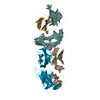
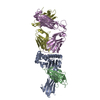
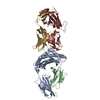
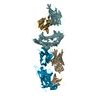
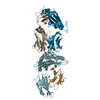
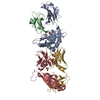
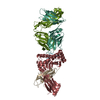
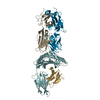

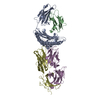
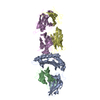
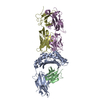
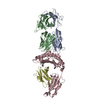
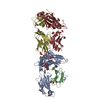
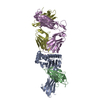
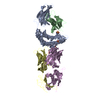
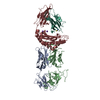
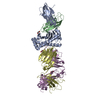
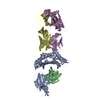
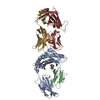
 PDBj
PDBj











